Research
Some recent research results in the MIMO+X group
Attention-aided MMSE for OFDM Channel Estimation
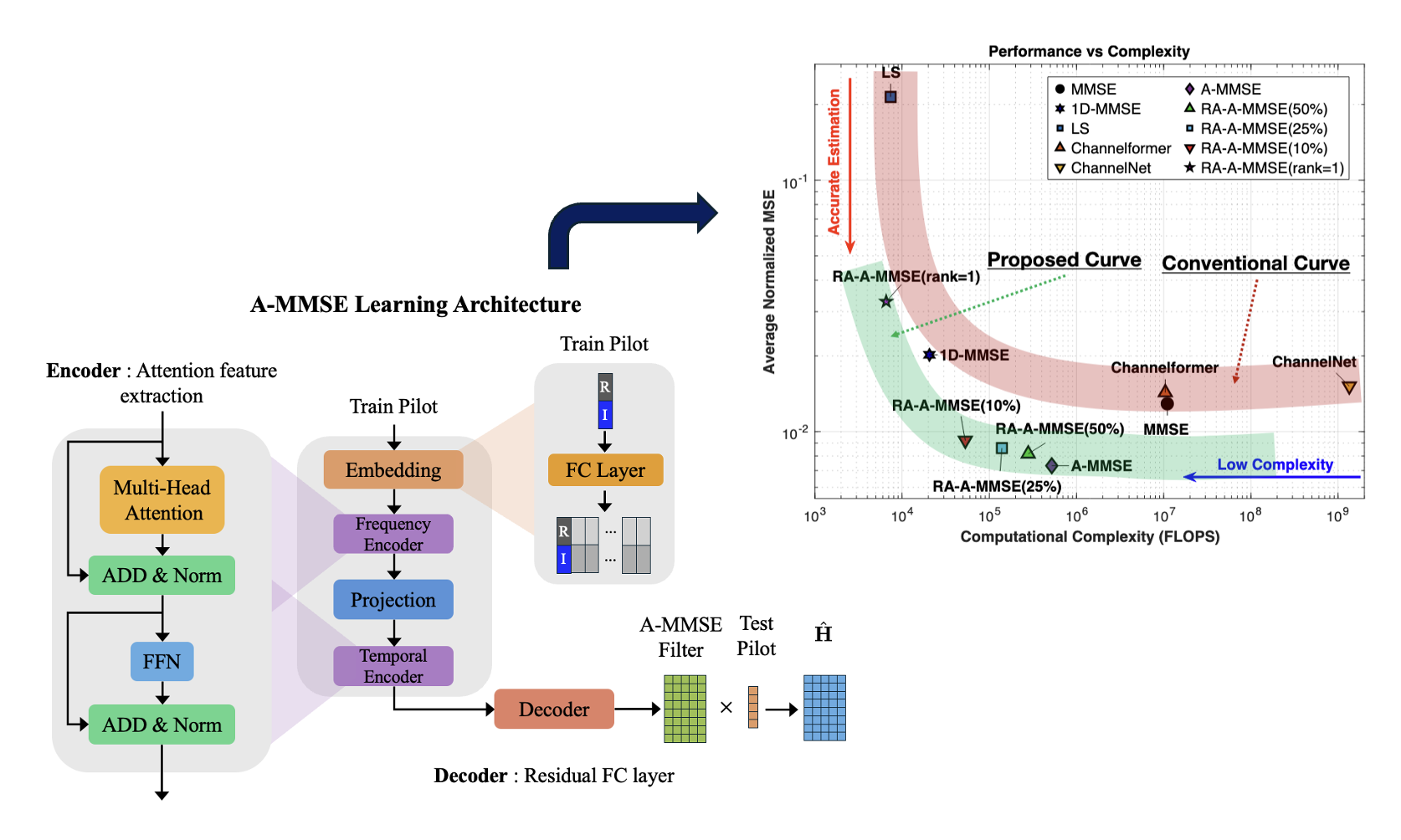 |
Accurate channel estimation is essential for reliable OFDM communication, yet conventional MMSE methods rely on hard-to-obtain channel statistics, and deep learning models often suffer from high complexity and low interpretability.
To address this, we propose Attention-aided MMSE (A-MMSE), a model-based learning approach that leverages an Attention Transformer to learn a linear estimation filter. Once trained, the filter enables fast and efficient channel estimation using only linear operations. A two-stage attention encoder explicitly captures frequency and temporal correlations in the channel, leading to significantly improved accuracy and robustness. A rank-adaptive extension allows flexible control over complexity, making it suitable for real-world 5G and upcoming 6G systems.
Related Publications
T. Ha, C. Jung, H. Kim, J. Park, and J. Park, “Attention-Aided MMSE for OFDM Channel Estimation: Learning Linear Filters with Attention,” submitted to IEEE Journal of Selected Areas in Communications. [Arxiv].
T. Ha and J. Park, “Attention-Aided MMSE for OFDM Channel Estimation,” accepted to 2025 Asilomar Conference on Signals, Systems, and Computers (Asilomar).
Massive MIMO for Multibeam Satellites
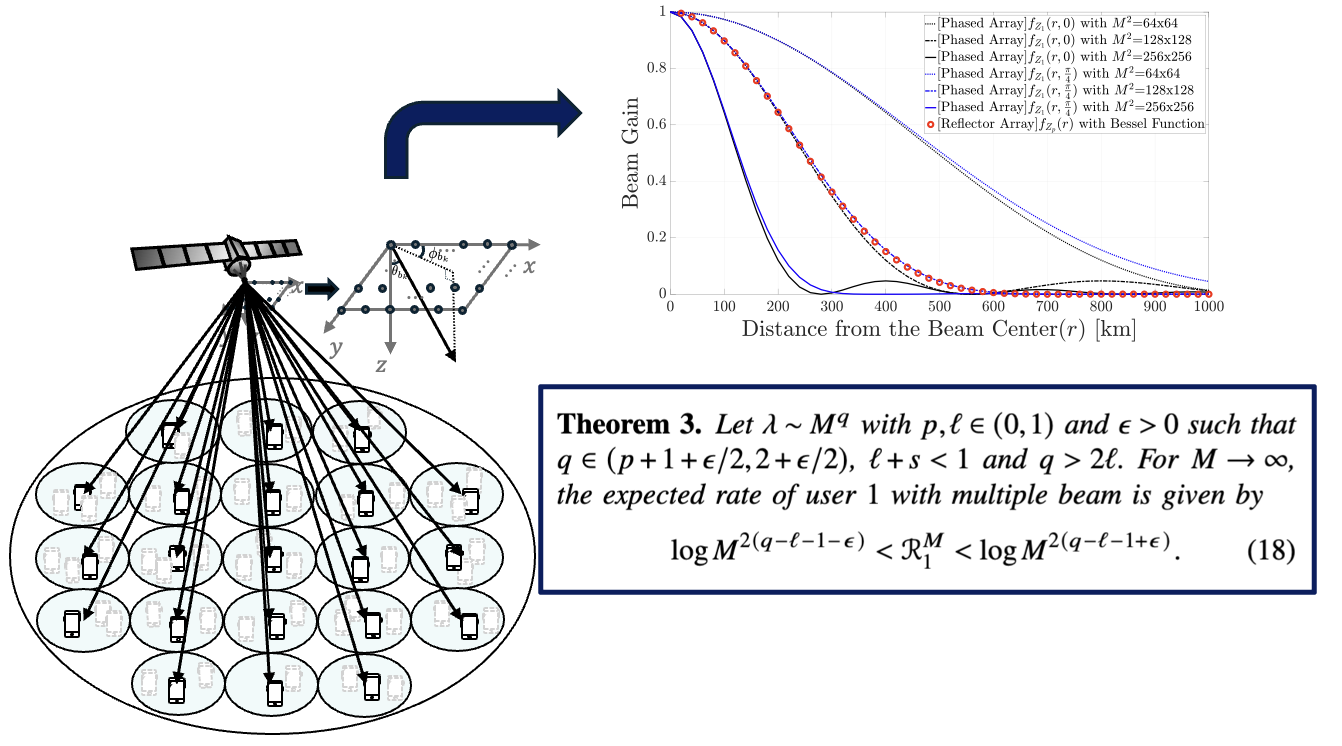 |
In the MIMO literature, the principle of multi-user diversity has been extensively investigated, revealing several notable findings such as: i) random beamforming is asymptotically optimal when combined with user selection ii) near-optimal rate performance gains can be achieved through linear precoding methods
In our work, we reinterpret multi-user diversity in the context of satellite communications, which are characterized by i) LoS channels and ii) 3D geometry with UPA antennas. Interestingly, satellite systems inherently align with the concept of random beamforming, as they typically employ fixed-beam precoding directed toward specific spatial regions. Our major findings are: i) When user density scales linearly with the number of antennas, the proposed precoding scheme can asymptotically achieve a constant fraction of the optimal rate. ii) To preserve asymptotic optimality as the number of beams increases, the user density must scale with an additional factor that compensates for the growing inter-beam interference.
Related Publications
S. Kim, J. Choi, W. Shin, N. Lee, and J. Park, “Multibeam Satellite Communications with Massive MIMO: Asymptotic Performance Analysis and Design Insights,” accepted to IEEE Transactions on Wireless Communications, May 2025. [Arxiv]
S. Kim and J. Park, “Asymptotic Performance Analysis of Multicast Satellte Communications with Massive MIMO,” submitted to IEEE Wireless Communications Letters.
S. Kim and J. Park, “Asymptotic Analysis of Rate Scaling Law in Multibeam Satellite Communications,” submitted to 2025 IEEE Global Communications Conference (GLOBECOM).
Greedy RF Chain Selection for MIMO ISAC
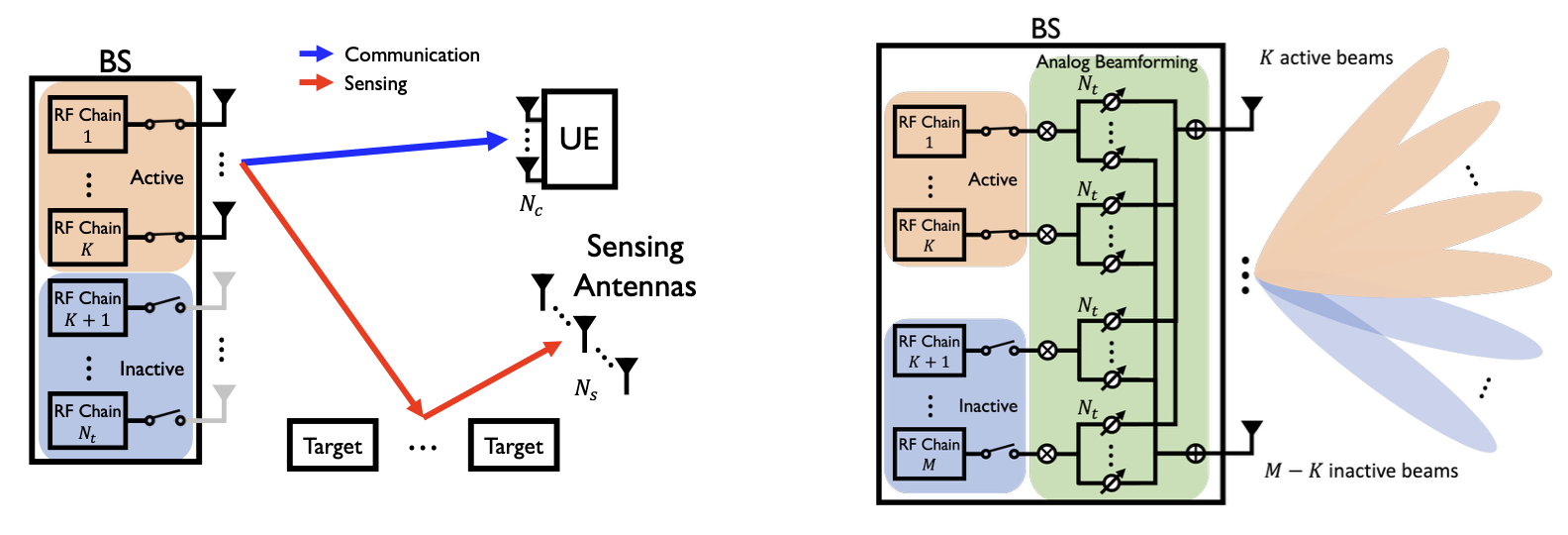 |
In 6G systems, the role of MIMO ISAC (Integrated Sensing and Communication) is becoming increasingly prominent. The growth in antenna count necessitates a proportional increase in RF chains, resulting in substantially higher power consumption. To mitigate this, antenna (RF chain) selection has emerged as a key technique for reducing hardware cost and energy consumption in MIMO-ISAC systems.
In this work, we present a greedy RF chain selection for MIMO ISAC, in which candidate RF chains are sequentially selected based on their contribution to a unified mutual information (MI) performance metric.
Related Publications
S. Shin, S. Jung, J. Choi, and J. Park, “Efficient RF Chain Selection for MIMO Integrated Sensing and Communications: A Greedy Approach,” submitted to IEEE Transactions on Communications. [Arxiv]
S. Shin and J. Park, “Beam Selection in MIMO-ISAC Systems: A Greedy Approach,” accepted to 2025 Asilomar Conference on Signals, Systems, and Computers (Asilomar).
Shot in the Dark – MIMO without CSIT
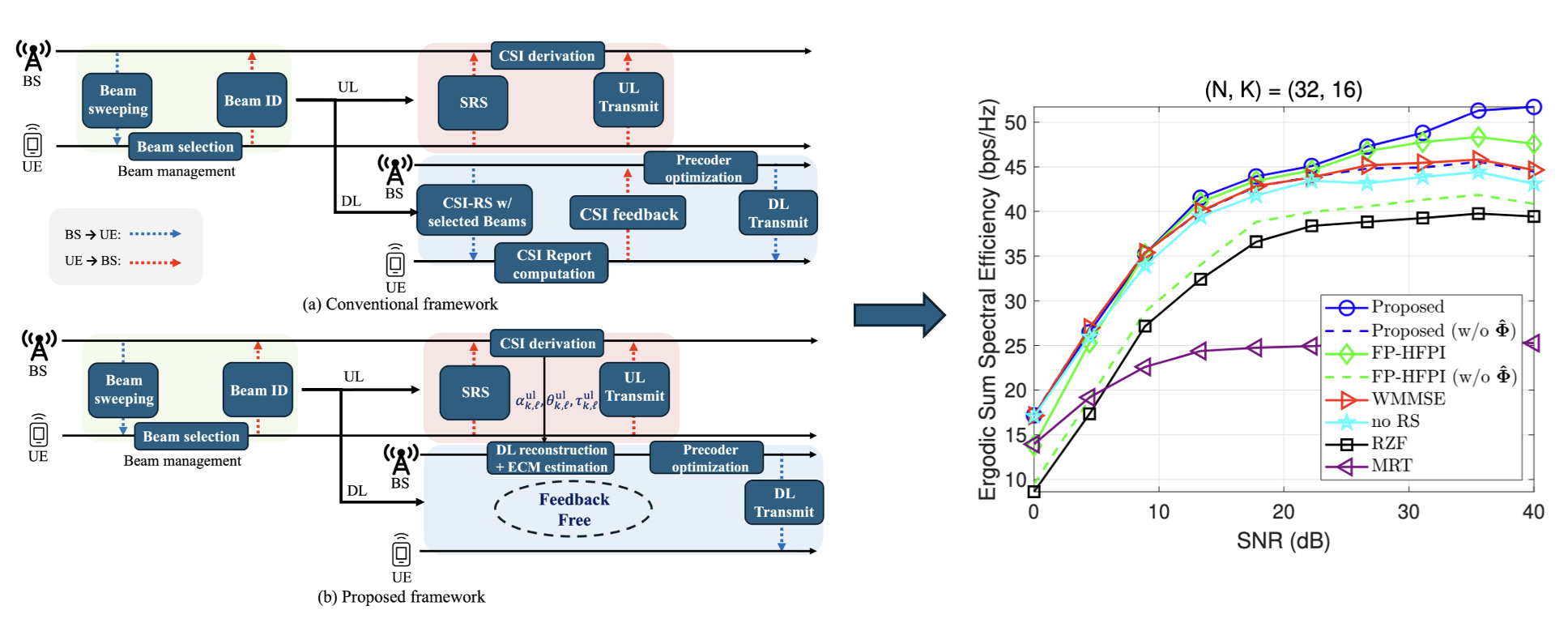 |
In MIMO downlink systems, the acquisition of accurate CSIT has long been a major challenge, especially in scenarios with limited feedback or rapidly changing channels.
In our recent work, we propose a novel framework that avoids reliance on explicit CSIT feedback by leveraging partial channel reciprocity between the uplink and downlink. By exploiting shared channel characteristics, the proposed method directly predicts the downlink CSI from the uplink estimated CSI, enabling efficient and robust downlink transmission with significantly reduced overhead associated with CSI.
Related Publications
N. Kim, I. P. Roberts, and J. Park, “Splitting Messages in the Dark – Rate-Splitting Multiple Access for FDD Massive MIMO without CSI Feedback,” in IEEE Transactions on Wireless Communications, vol. 24, no. 4, pp. 3320-3332, April 2025. [Arxiv]
N. Kim, J. Han, J. Choi, A. Alkhateeb, C. -B. Chae, and J. Park, “Integrated Sensing and Communications in Downlink FDD Massive MIMO without CSI Feedback,” submitted to IEEE Transactions on Wireless Communications. [Arxiv] (Under Revision)
J. Han, N. Kim, and J. Park, “Reducing Latency by Eliminating CSIT Feedback: FDD Downlink MIMO Precoding without CSIT for Internet-of-Things Communications,” submitted to IEEE Internet of Things Journal. [Arxiv] (Under Revision)
N. Kim and J. Park, “Robust Precoding and Rate-Splitting Multiple Access for FDD Massive MIMO Without CSI Feedback,” accepted to 2025 IEEE International Symposium on Information Theory (ISIT).
Y-Twin (made with Sionna)
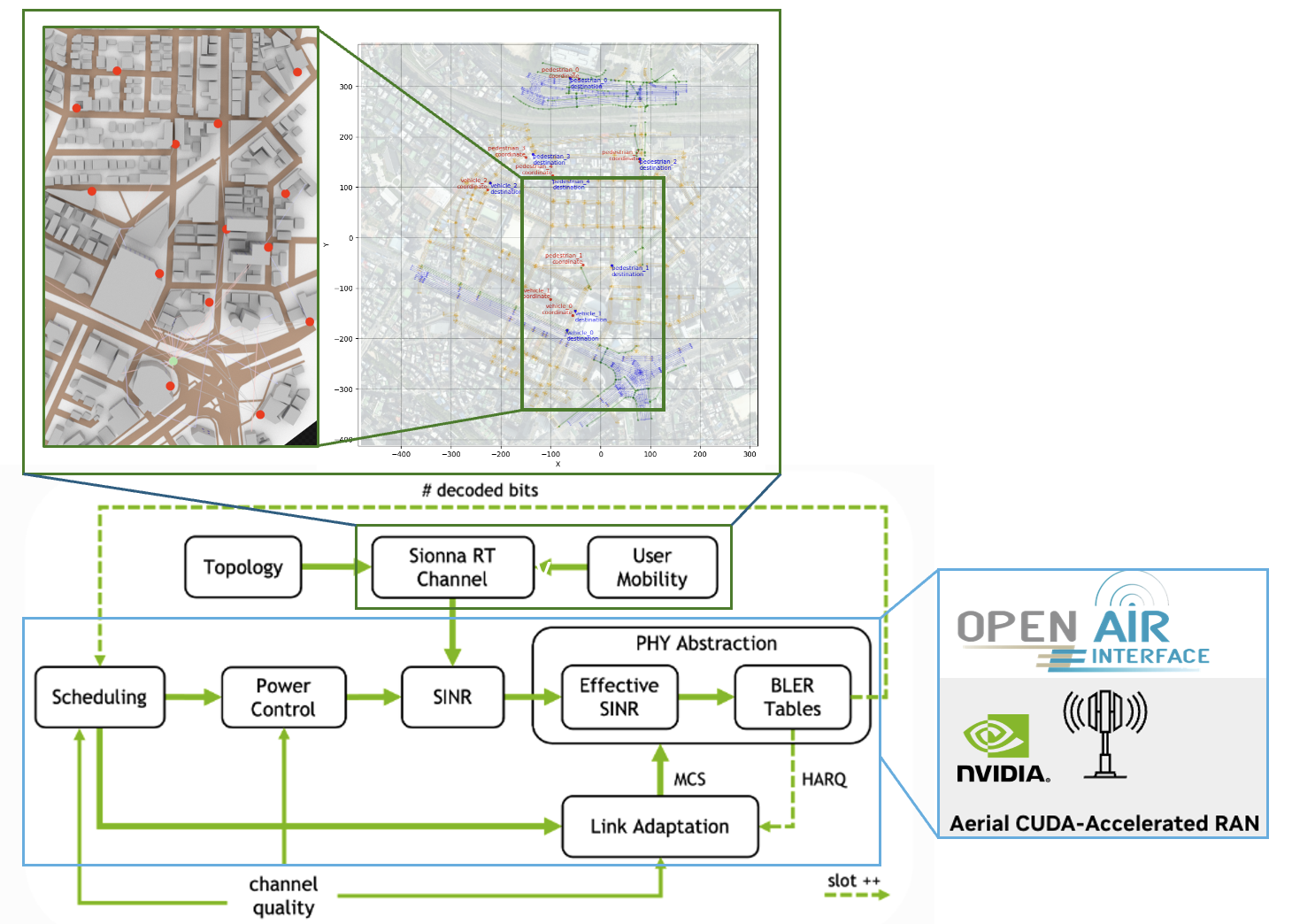 |
We have developed a custom digital twin, named Y-Twin, which fully reflects the geometry, traffic dynamics, and mobility patterns of the Sinchon area near Yonsei University. Built on top of the Sionna framework, Y-Twin supports fully functioning RAN emulation, enabling end-to-end wireless system evaluation in a realistic urban environment. This platform is expected to serve as a foundation for a wide range of AI-native RAN research in the near future.
Dataset, structure, and usage details will be made available soon.
Related Publications
G. Kim and J. Park, “Y-Twin: A Digital-Twin Framework for Advanced Physical-Layer Research,” in preparation.
State Estimation with 1-bit Observation and Imperfect Model
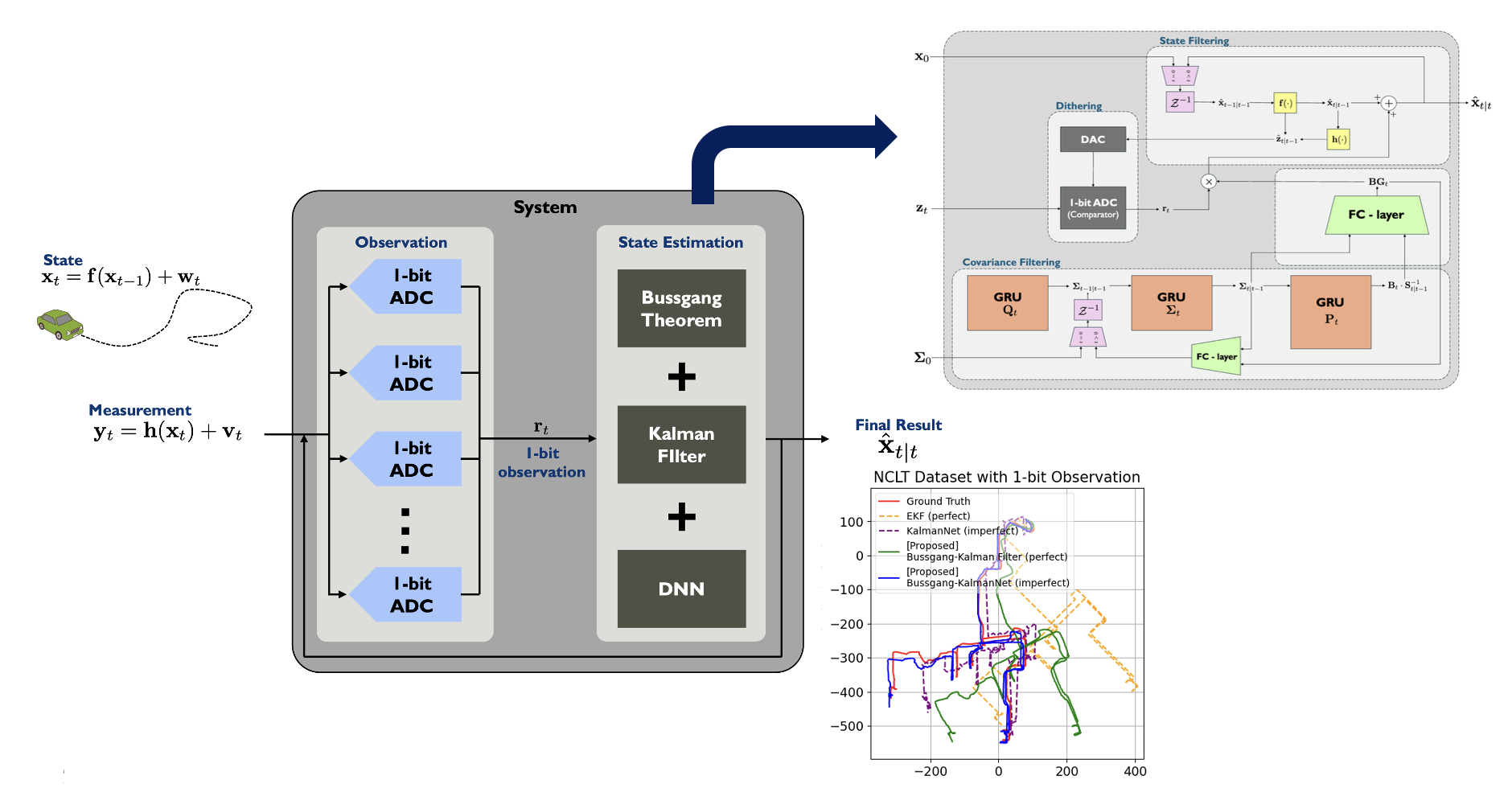 |
State estimation is an important problem for estimating a system’s hidden state, and Kalman filter is commonly used for this purpose. Most of the existing algorithms assume ideal environment (infinite resolution or full model knowledge, etc), so their performance degrades in real-world environments.
This work considers a state estimation problem with 1-bit observation and imperfect models. By using the well-knonw Bussgang theorem to approximate nonlinear inputs linearly, we get a linear filter structure while accounting for ADC quantization distortions. To overcome model uncertainties and nonlinearities, we propose a hybrid DNN approach that integrates Bussgang-based linearization with data-driven learning for robust and efficient inference.
Related Publications
G. Choi, J. Park, N. Shlezinger, Y. C. Eldar, and N. Lee, “Split-KalmanNet: A Robust Model-based Deep Learning Approach for State Estimation,” in IEEE Transactions on Vehicular Technology, vol. 72, no. 9, pp. 12326-12331, Sept. 2023. [Arxiv].
C. Jung, T. Ha, H. Kim, and J. Park, “State Estimation with 1-Bit Observations and Imperfect Models: Bussgang Meets Kalman in Neural Networks,” submitted to IEEE Transactions on Signal Processing. [Arxiv]
C. Jung and J. Park, “Finding a Path from 1-bit Quantizer: State Estimation with 1-Bit Observations and Imperfect Models,” accepted to 2025 Asilomar Conference on Signals, Systems, and Computers (Asilomar).
MIMO-ME-MS Channel
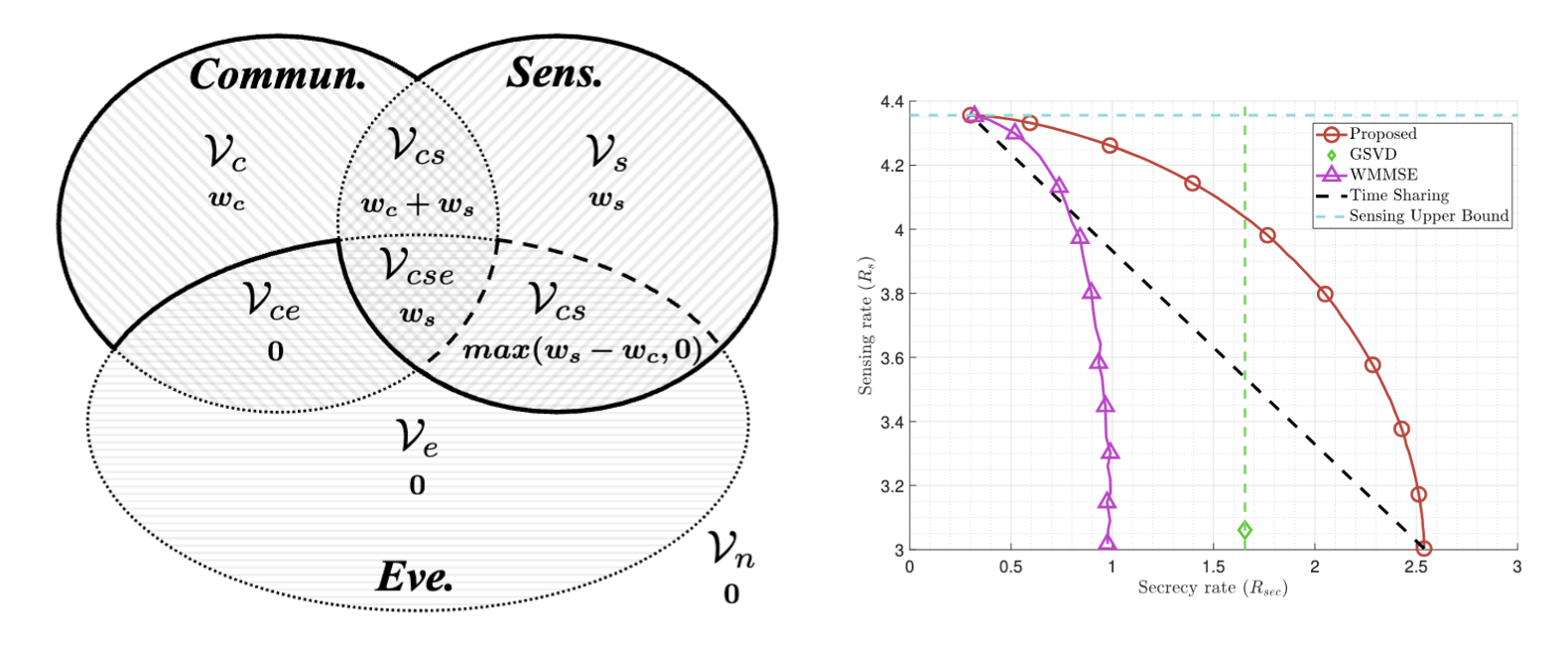 |
In this work, we introduce the MIMO-ME-MS channel, which comprises a multi-antenna transmitter and receiver, along with a multi-antenna eavesdropper and sensing receiver. Within this framework, we investigate the quasi-optimal precoder structure via subspace analysis and propose an iterative precoding design method tailored to this setting.
Related Publications
S. Jung, N. Lee, and J. Park, “The MIMO-ME-MS Channel: Analysis and Algorithm for Secure MIMO Integrated Sensing and Communication,” submitted to IEEE Journal of Selected Areas in Communications.
Research Support
Our group has been funded by a diverse range of government and industry sponsors. Our group gratefully acknowledges ongoing and past support from NRF, IITP, KRIT, Samsung, Intellian Technologies.
 |